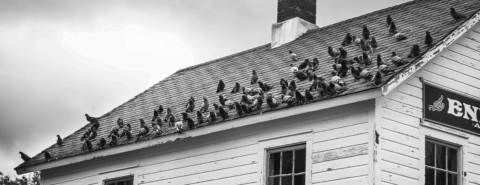The sound of suspense: Hitchcock and Herrmann [playlist]

The sound of suspense: Hitchcock and Herrmann [playlist]
Listen to Bernard Herrmann’s eight scores for the films of Alfred Hitchcock. You’ll hear, in music, a mirror of how the duo’s personal relationship evolved, from its joyous start in late 1954 to its bitter end in 1966.
At the recording session for their first collaboration, The Trouble with Harry (1955), Hitchcock chuckled with delight. Herrmann had translated Harry’s darkly comic tone into music. His new friend “Benny” also captured in the score the director himself—his anxieties, his wit, his romantic fantasies. So much so that in 1968, when Herrmann crafted a concert suite from Harry, he titled it “A Portrait of Hitch.”
Their second pairing shows how quickly Herrmann joined Hitchcock’s inner circle. In 1956’s The Man Who Knew Too Much, Benny didn’t just write the score. He appears onscreen as himself, conducting the London Symphony in the film’s most famous set-piece: an attempted assassination in the Albert Hall. Herrmann’s main title “Prelude” is barely two minutes long; but it contains the seeds of all the main themes he’ll develop in the score. The “Prelude” also foreshadows the Albert Hall sequence with its concert-hall grandeur.
The Wrong Man (1956) may be their most surprising collaboration. To tell the true story of a jazz musician’s wrongful arrest, and the tragic impact it has on his family, Hitchcock used a more realistic visual style, and filmed in the story’s actual locations. For its “Prelude,” Herrmann delivers a surprise of his own: a lively samba tune that seems far removed from his usual style. But its sunny first measures are repeatedly answered—arrested?—by an ominous phrase for woodwinds that hints at the darkness to come.
Director and composer were at their best when depicting romantic obsession, and 1958’s Vertigo may be the summit of both artists’ careers. The psychological disorientation felt by James Stewart’s protagonist is conveyed by Herrmann’s famous “Prelude,” with its relentlessly repeating figures and orchestral swells. Hitchcock tailored the movie’s edit and its sound design to accommodate the music, most famously in Vertigo’s emotional climax. As Robert Burks’s camera glides 360 degrees around Scottie Ferguson (Stewart) and Judy Barton (Kim Novak), there is no dialogue—only Herrmann’s passionate “Scene d’amour.” As Hitchcock told his composer, “We’ll just have the camera and you.”
1959’s North by Northwest gave Herrmann his best opportunity to blend thrills with humor (he regretted that he was never asked to score comedies). Like Vertigo, the main titles of North by Northwest are a miniature movie in themselves, as designer Saul Bass’ perpendicular lines streak across Manhattan skyscrapers and bustling commuters.
Someone at MGM suggested that since the movie begins in New York City, the main title music should be “Gershwinesque.” What Herrmann did instead reflects his lifelong gift for thinking outside the box. His “Prelude” is based on the rhythm of a Spanish fandango—because, as the composer observed, the movie isn’t about New York: it’s about the “crazy dance that was going to happen now between Cary Grant and the world.”
When Grant’s man-on-the run meets a sexy blonde (Eva Marie Saint) on a train, the actors have just a few minutes to establish that this relationship is more than a casual one-night stand. Herrmann’s shimmering “Conversation Piece” is among his finest love themes, and convinces us in seconds that this couple is destined to share train berths for years to come.
If not for Herrmann, Psycho might survive today only in massively shortened form. After viewing a rough cut without music, Hitchcock decided that he had failed in his biggest gamble: a self-financed, low-budget shocker, targeted at young moviegoers hungry for edgy content. Hitch mused about cutting it down and putting it on his TV series. Herrmann watched the cut and saw what the director didn’t. He transformed the film with his all-strings score, “a black-and-white sound” to complement the black-and-white photography. His nerve-shredding “Prelude” was composed with one goal in mind—to tell moviegoers that, despite Psycho’s leisurely first scenes, “something terrible is going to happen.”
Hitchcock made only one request of his composer: no music for the murder scenes. Herrmann felt differently, leading to the ultimate validation of his film career. When Hitchcock heard the shrieking strings his composer unleashed for Marion and Arbogast’s killings, he admitted he had been wrong.
By the time Herrmann completed Marnie (1964), the onscreen tension was matched by a growing division between director and composer. Herrmann’s abrasiveness, and movie studios’ appetite for pop/rock soundtracks, were two of the factors that drove a wedge in what had been the closest of partnerships. Finally, on Torn Curtain (1966), Herrmann dared to write what he thought was best for the film—a brutal, dissonant score—even though it was the opposite of what Hitchcock had asked for. (Hitch wanted music that was “light” and with a “beat.”) Minutes after hearing Herrmann’s “Prelude,” their partnership and friendship came to an ugly end. The composer was fired, his score rejected.
Some of that music reached movie screens in 2019, when Quentin Tarantino featured two Torn Curtain cues in Once Upon a Time…in Hollywood. Nearly all of the scores represented here have surfaced in other media, re-used in Best Picture winners (The Artist), music videos (Lady Gaga’s Born This Way), TV (The Simpsons, Wednesday), plus commercials, pop songs and ringtones.
It’s easy to understand why. Herrmann remains unmatched in writing music that evokes timeless emotions—fear, love, hate, dread. And just as the gorgeous nightmares of Hitchcock’s cinema remain universal, the music of Bernard Herrmann is the fitting soundtrack of our own, anxious times.
Photo by Gary Meulemans on Unsplash.
Oxford University Press's Blog
- Oxford University Press's profile
- 237 followers



